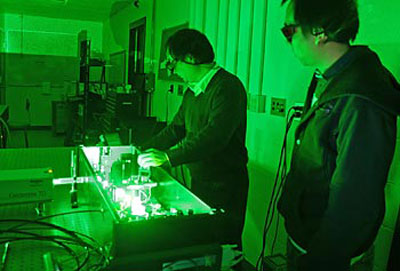| Nov 01, 2012 |
Scientists harness the power of photosynthesis
|
|
(Nanowerk News) Photosynthesis, the process by which plants, algae and many forms of bacteria use energy from sunlight to convert carbon dioxide and water into organic compounds while releasing oxygen as byproduct, could be the key to helping alleviate the world’s energy needs, decrease its dependence on fossil fuels and address environmental concerns such as the high concentrations of carbon dioxide in the atmosphere.
|
|
A team of researchers at UMass Lowell are now able to replicate photosynthesis in the laboratory, with the goal of someday storing solar energy on a commercial scale. The team’s work is funded with a three-year grant from the National Science Foundation (NSF) worth nearly $417,000.
|
 |
| Assoc. Prof. Mengyan Shen, left, and his research team aim to discover a cost-effective process for manufacturing hydrocarbon fuels from sunlight, carbon dioxide and water on a commercial scale to meet global energy needs.
|
|
“Sunlight is a renewable and environment-friendly energy source that could potentially become the ultimate global energy solution,” says physics Assoc. Prof. Mengyan Shen, head of the University’s Laboratory for Nanoscience and Laser Applications and the principal investigator (PI) for the NSF project.
|
|
Other members of the team include Prof. David Ryan and Assoc. Prof. Marina Ruths of the Chemistry Department, who are the co-PIs; postdoctoral researcher Cong Wang and graduate student Qinghua Zhu.
|
|
Research Has a Broad Impact
|
|
The team uses novel nanostructure arrays on solid metal surfaces to convert carbon dioxide and water directly into hydrocarbon compounds for storing solar energy. Intense laser pulses are used to irradiate the surfaces of cobalt or iron microparticles and induce the formation of the nanostructure arrays.
|
|
“Photosynthesis involves dissociating carbon dioxide into carbon monoxide and oxygen, and water into hydrogen and oxygen, and then synthesizing hydrocarbons from the hydrogen and carbon monoxide,” explains Shen. “With metal nanostructures formed with femtosecond laser irradiation, a nature-like photosynthesis can be easily achieved and maintained at low cost using Earth-abundant metals.”
|
|
He says the efficiency for storing solar energy using the group’s present simple experimental setup is about 10 percent, which they hope to improve even further.
|
|
“Information gained from this research on the properties of metal nanostructures will be of value to other fields where nanostructures and photo-physics, chemistry and biology are widely used, such as medicine, the environment, chemical production and military and homeland security,” notes Shen. “Our proposed method is also potentially applicable to fertilizer production with sunlight, which could greatly impact agriculture and the world’s food supply.”
|

